KANTO TUK vs. AIRPULSE A100
The ten liter Air Motion Transformer premium active desktop speaker battle
Introduction:
To be fair, the 2020 Chevrolet Corvette Stingray has a 6.2 liter machine only, which means - when it comes to capacity - it can't beat neither KANTO TUK nor the AIRPULSE A100, who are competing in this review for the crown of the 10 11,5 liter class active amplified desktop speaker with extras. Too bad!
However, the astonishing beautiful 2020 Corvette Stingray would be Class A anyway, wouldn't it? That's not what we are looking at today. We are dealing with economic and turbocharged Class D.
These little gems also won't provide a fake aural impression thus projecting the sound truthfully to enlighten your heart providing highest resolution.
Did it resonate well? Automotive comparisons are so convenient in our hobby, and I swear, I absolutely appreciate the elegance of the new Stingray. Simply put, a beautiful design. What brings me back to our contestants: Both, the KANTO TUK and the AIRPULSE A100, in my personal opinion, share an extraordinary visual presence and have even a lot more in common than their good looks only.
One example: Usually both speakers are sold at 799 $.
Related to this review, AIRPULSE has provided a special discount for Audiophile Style readers until the end of May. Details are to be found at the end of the article. 😉
Some important questions about active desktop speakers - a small Q&A with myself
Q: Do I want to have a complete 2nd component based system dominating my workspace? With Streamer/DAC/Amp and passive desktop speaker?
A: No, not at all, I have a fully fledged system some 4 meters away from my desk in the same room, that suits my need for component based audio most of the time.
Q: If going active, what’s more important at 800 bucks: the choice of tweeter or the choice of amplification?
A: The use of AMT technology sounds more significant for me, if it presents a significantly better soundstage and midrange. I am also convinced that - at that price level - well implemented Class D amplification beats most A/B technology in terms of performance, efficiency and economics. Especially when used with digital inputs and DSP. If - as an economic consequence - it does allow as well for the use of an Air Motion Transformer Tweeter, I'd call it a win/win situation.
Q: Some active studio monitors with balanced inputs are pretty fly in that price segment?
A: Yes, I have noticed that and decided against. I have no signal source with balanced output close to my desk, which in turn would only make me think about designing a different signal path if I was tempted to use balanced connections.
Q: What do you want from your desktop speaker?
A: Good looks, exciting sound, remote control, a set of analogue and digital inputs and the subwoofer output option, in case they should be used in another environment where subs are suitable (i.e. living room, garden deck or at our secondary home).
Q: What about streaming options ? How much do you need?
A: Both models have Bluetooth AptX for the worst case scenario of non-lossless signal transport. In any other case the fallback would be a mobile phone connected via OTG to the internal digital amplifier. As the units are close to my PC, no wifi or ethernet connection is obligatory, they will usually support what I am consuming at the screen and may be seen as a solution to give my headphone set a rest. For other uses, I could dream about WiFi or Ethernet, but in 2020 these features are still reserved for the +1k class of active speakers. Optionally, streaming options can be had at very reasonable prices for making the best out of them. Though, Roon, might only work with direct USB connection.
Q. What are the important prerogatives for the competition?
A: Dimensions like footprint & volume, Air Motion Transformers tweeter, excellent connectivity.
The squared circle:
Both premium active desktop speakers are within certain parameters that qualify them as near field speakers on my office desk, even more so than for book shelves or as stand mounted speakers (a use case they certainly can fit as well if necessary) in the living room. I'm working on a desk with a surface of about 1,116 sqin (0,72 sqm) and have assumed that the majority of readers may not use more than 1.500 sqin (0,98 sqm) in average as a surface for a PC/notebook environment.
In my view, the natural fit for such working space maxes out at appr. 11.5 liters of volume and occupied space of 62sqin (0,045 sqm) per speaker. These physical constraints equate to an extremely limited choice. A fact I came to notice, as there are only a few quality active speakers available which are sporting an Air Motion Transformer tweeter, a cool mix of analogue and digital inputs, remote control and subwoofer output.
Explicitly less, if these should provide some decent sound quality at an already premium price tag of 799 $, a sufficient amount of money, which the Kanto TUK and the AIRPULSE A100 were designed to ask for.
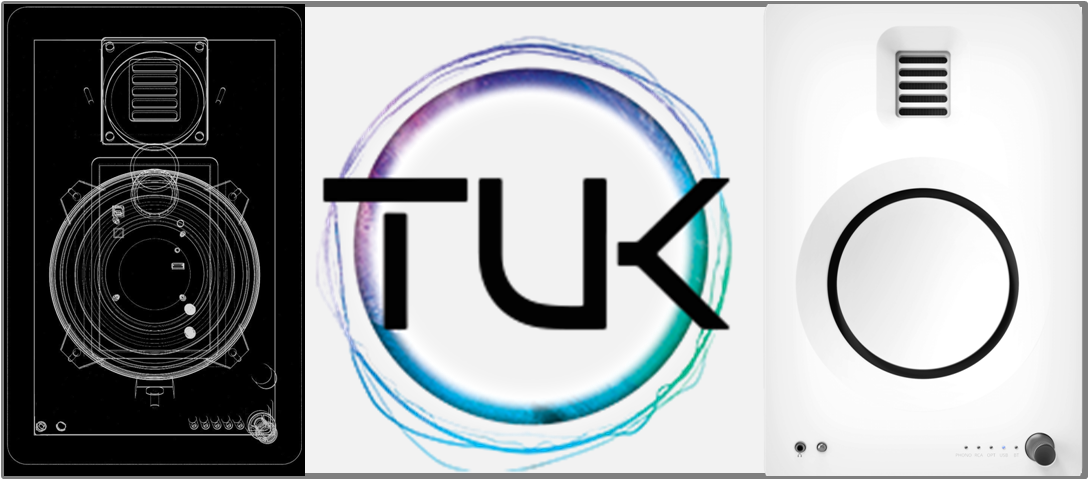
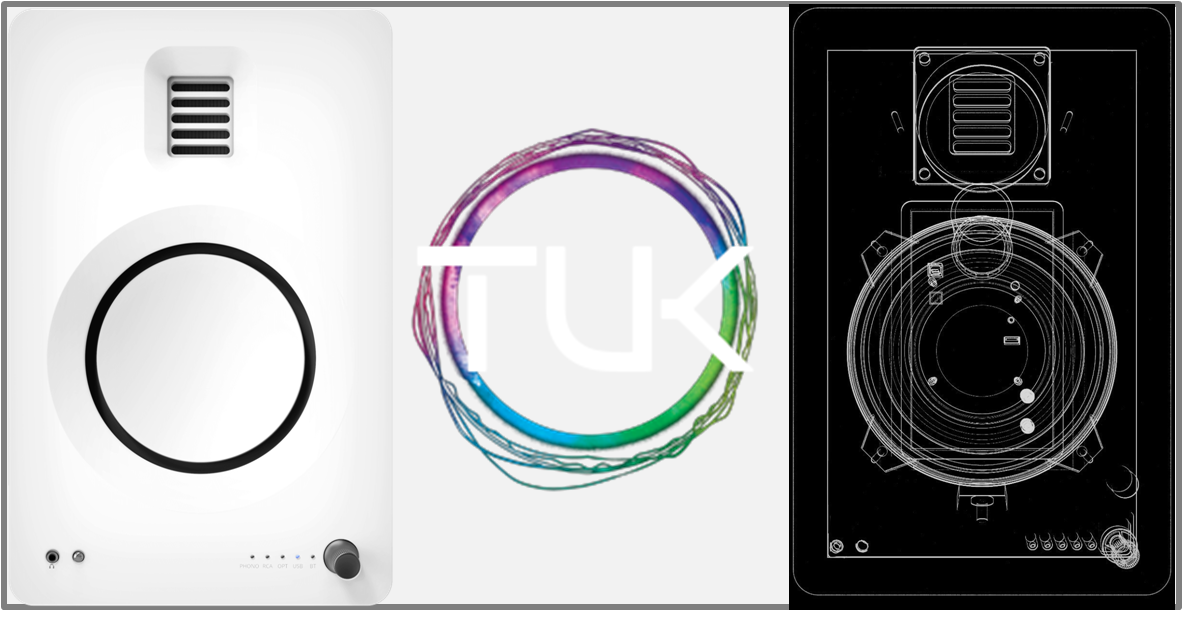

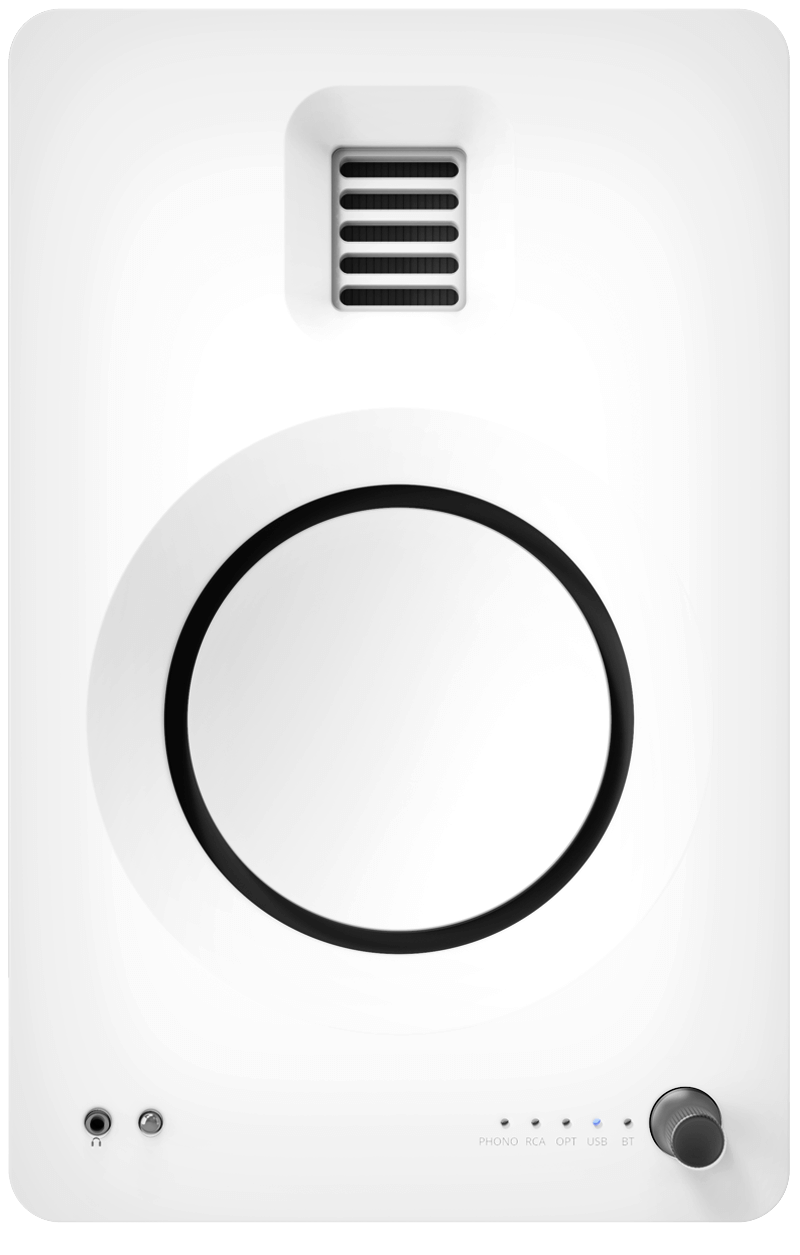


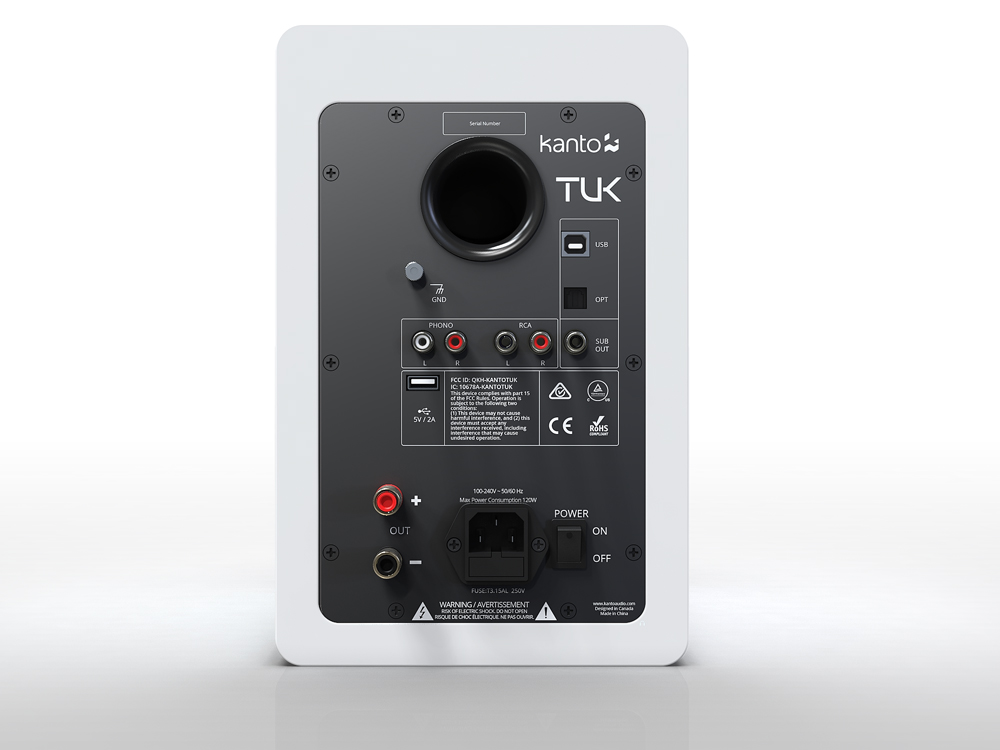



.jpg)

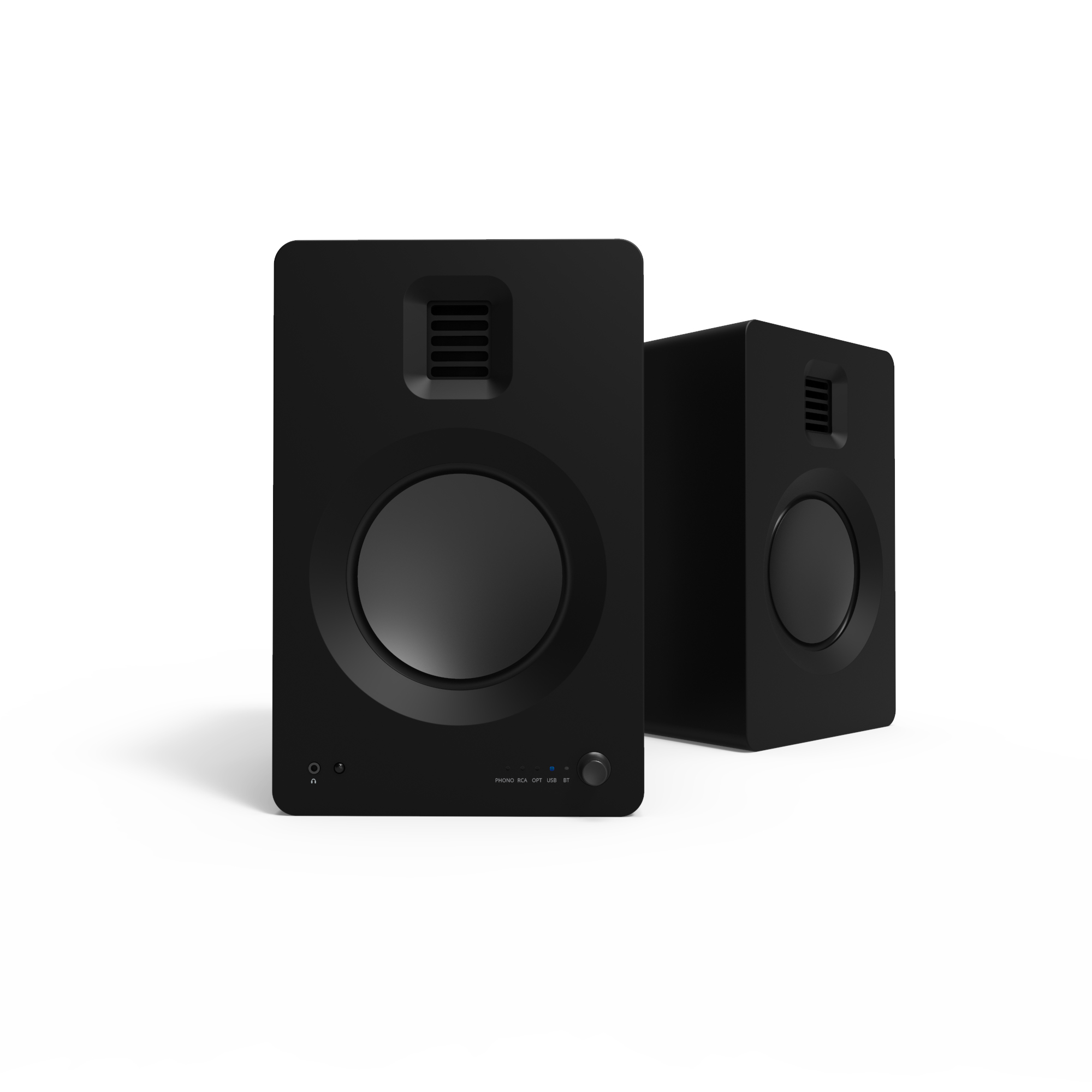



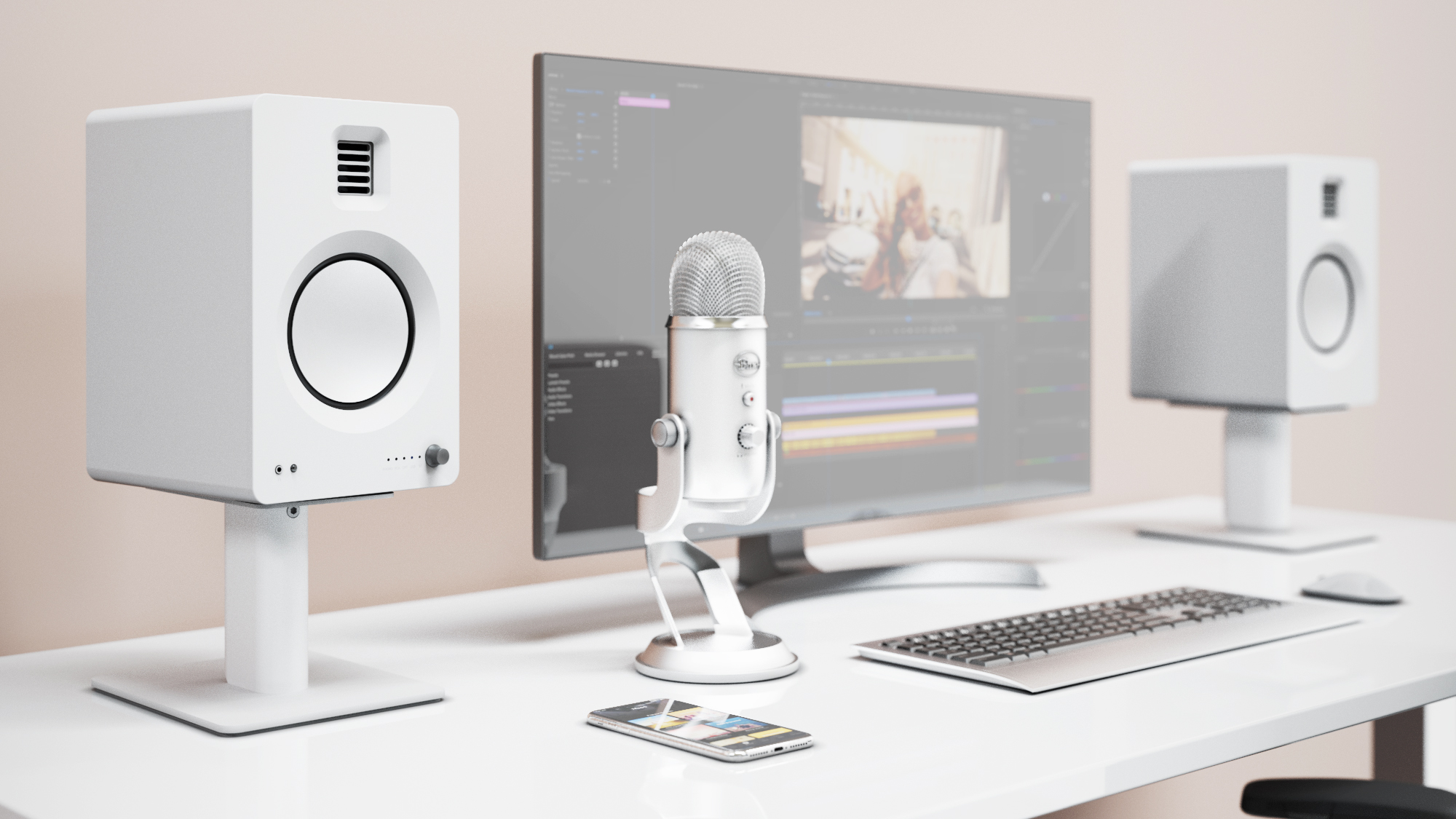
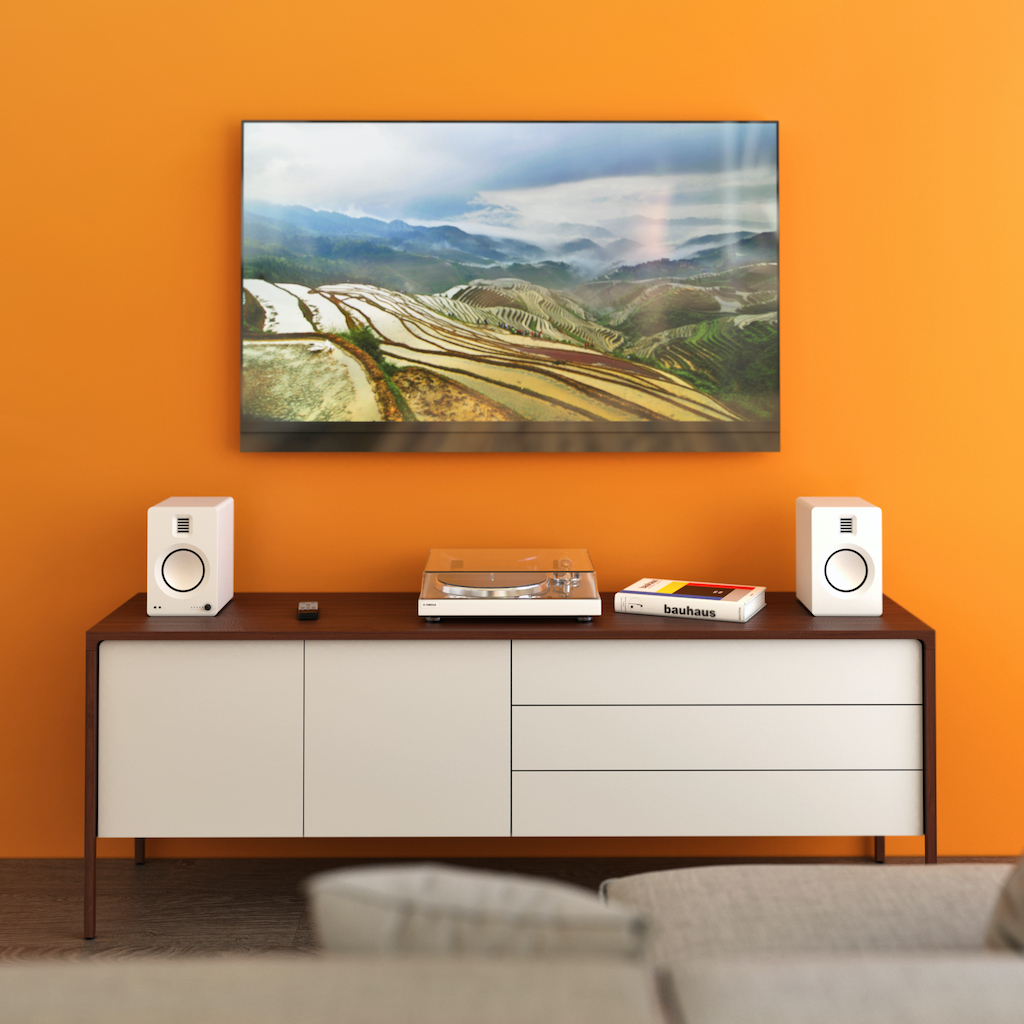
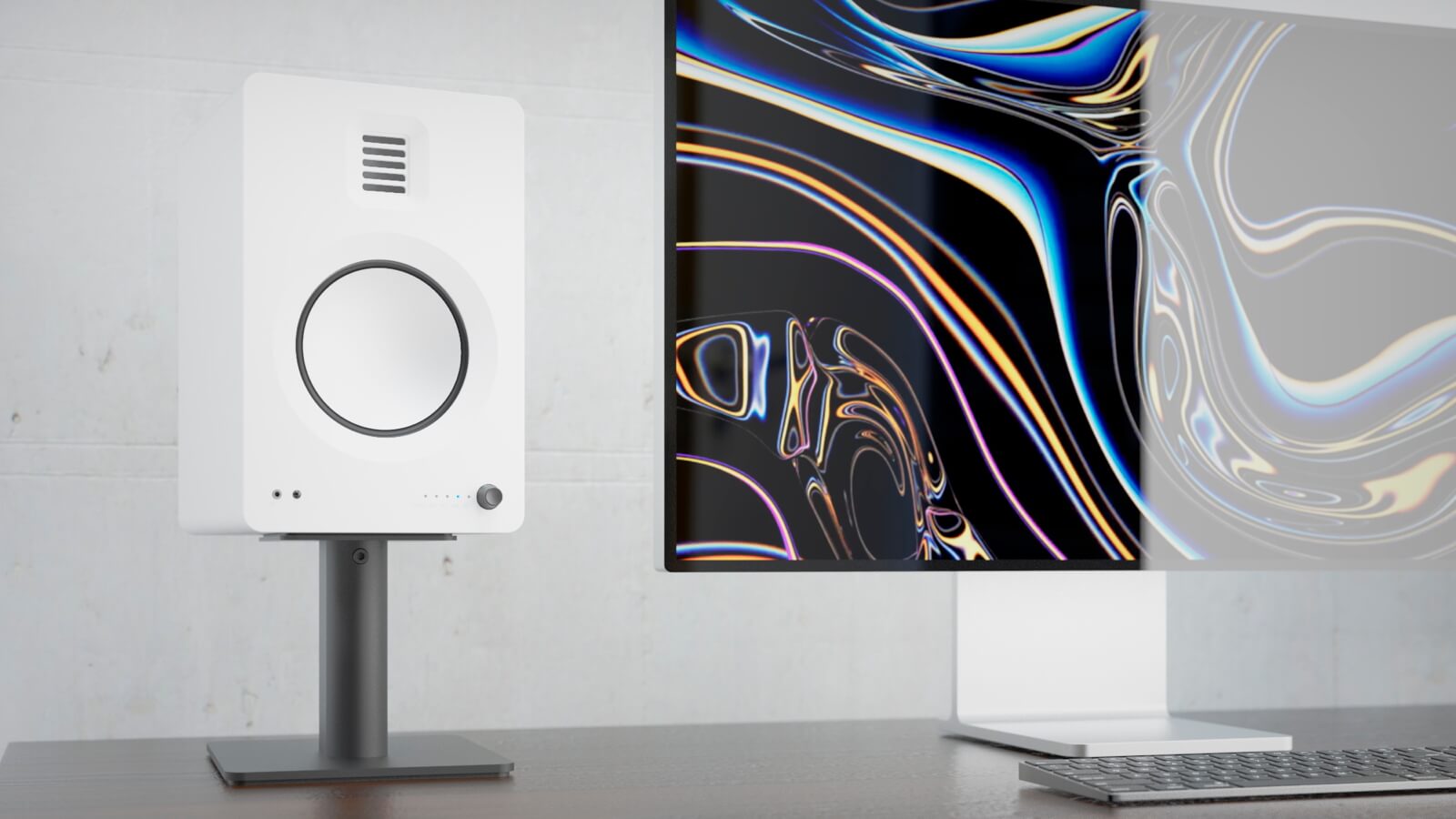
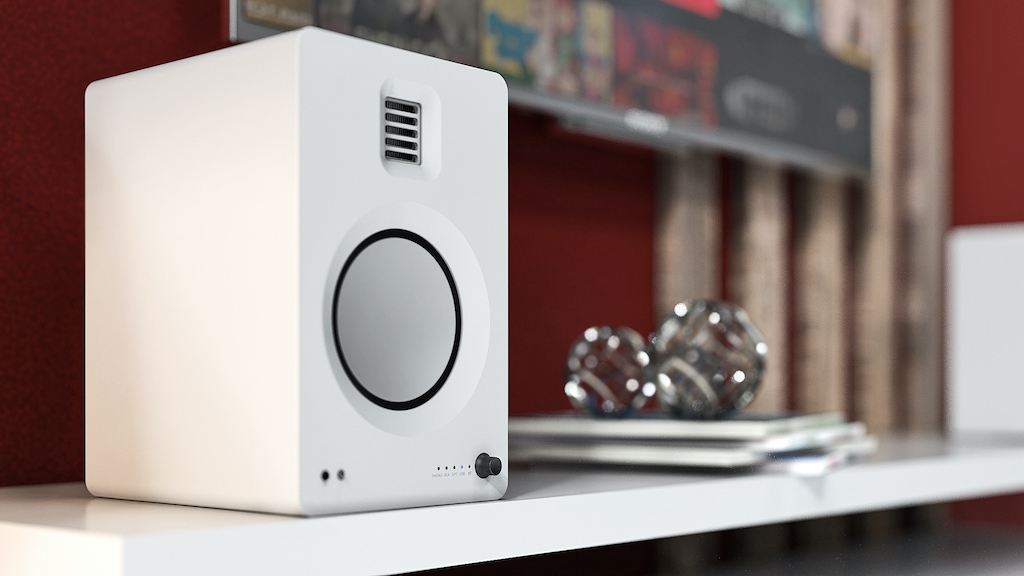



In the left corner - KANTO TUK
 The TUK's name arrives from TUKtoyakTUK, an Inuit settlement inside the Arctic circle, perhaps most commonly known in popular culture for "The Molson Ice Polar Beach Party" in 1995, promoting some refreshing Canadian beer, while the manufacturer refers the name for the product "being as dazzling as the aurora borealis which light up the night skies of the Canadian arctic."
The TUK's name arrives from TUKtoyakTUK, an Inuit settlement inside the Arctic circle, perhaps most commonly known in popular culture for "The Molson Ice Polar Beach Party" in 1995, promoting some refreshing Canadian beer, while the manufacturer refers the name for the product "being as dazzling as the aurora borealis which light up the night skies of the Canadian arctic."
KANTO Audio from Vancouver in Canada has been in the lifestyle-fi markets for the last couple of years, after they enhanced their earlier portfolio from television mounts and speaker stands. Their affordable, yet well regarded YU series of desktop/bookshelf speakers shows no visible similarity with the 2019 KANTO TUK, although they share the same brilliant idea of multi-connectivity via digital and analogue inputs combined with multiple Bluetooth pairings, subwoofer output and an USB charging port.
The TUK have pushed this concept to further heights by providing a Headphone socket, a hidden active crossover plus a mute function for the sub, a memory function for the eq settings of all inputs and channel swapping, which looks like a smart move in regard to the digital inputs.
On the lifestyle support side, USB charges up to 5v/2A, the LEDs are dimmable while the TUK features a smart power saving mode which KANTO had first introduced with the latest SYD bookshelf speaker. All functions are accessible via its new designed & stylish remote control. As the icing on the cake, KANTO had thoughtfully implemented "a ¼”-20 threaded hole to the bottom of TUK so it can be secured" to support on-wall installation or speaker stands.
The TUK has received a good share of well deserved praise and applause during the last 9 month, especially in the "audiophile" media, which makes me assume it provides a great success for KANTO in the mass market segment. Their absolutely impressive feature list together with its exquisite design makes the KANTO TUK an outstanding functional product, which is hard to come by any active speaker below 1000$. Actually, according to my research during the last 6 month, I couldn't find any active speaker in that price range that was showing the same feature set as the KANTO TUK.
Hence, I chose the AIRPULSE A100 for comparison, due to their very similar technical characteristics - Class D, AMT tweeter, 5inch woofer, BT, analogue & digital in and small footprint - at exactly the same listed price.


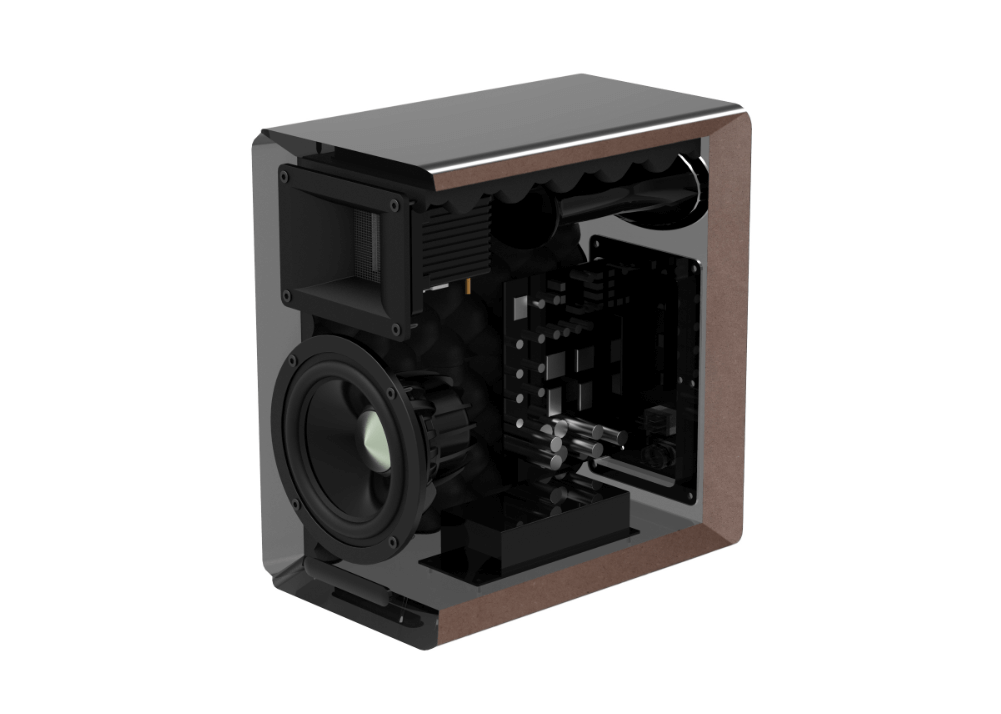
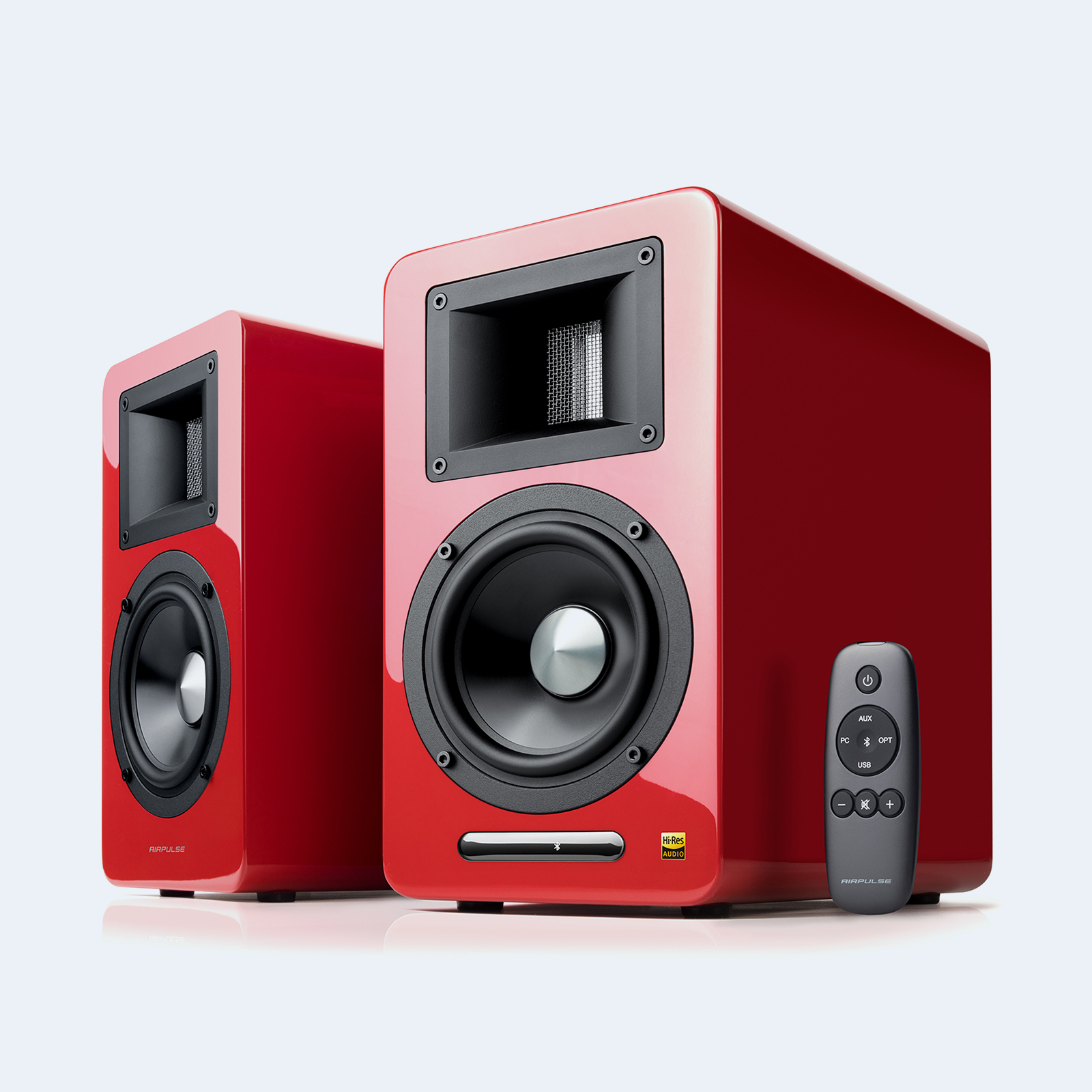

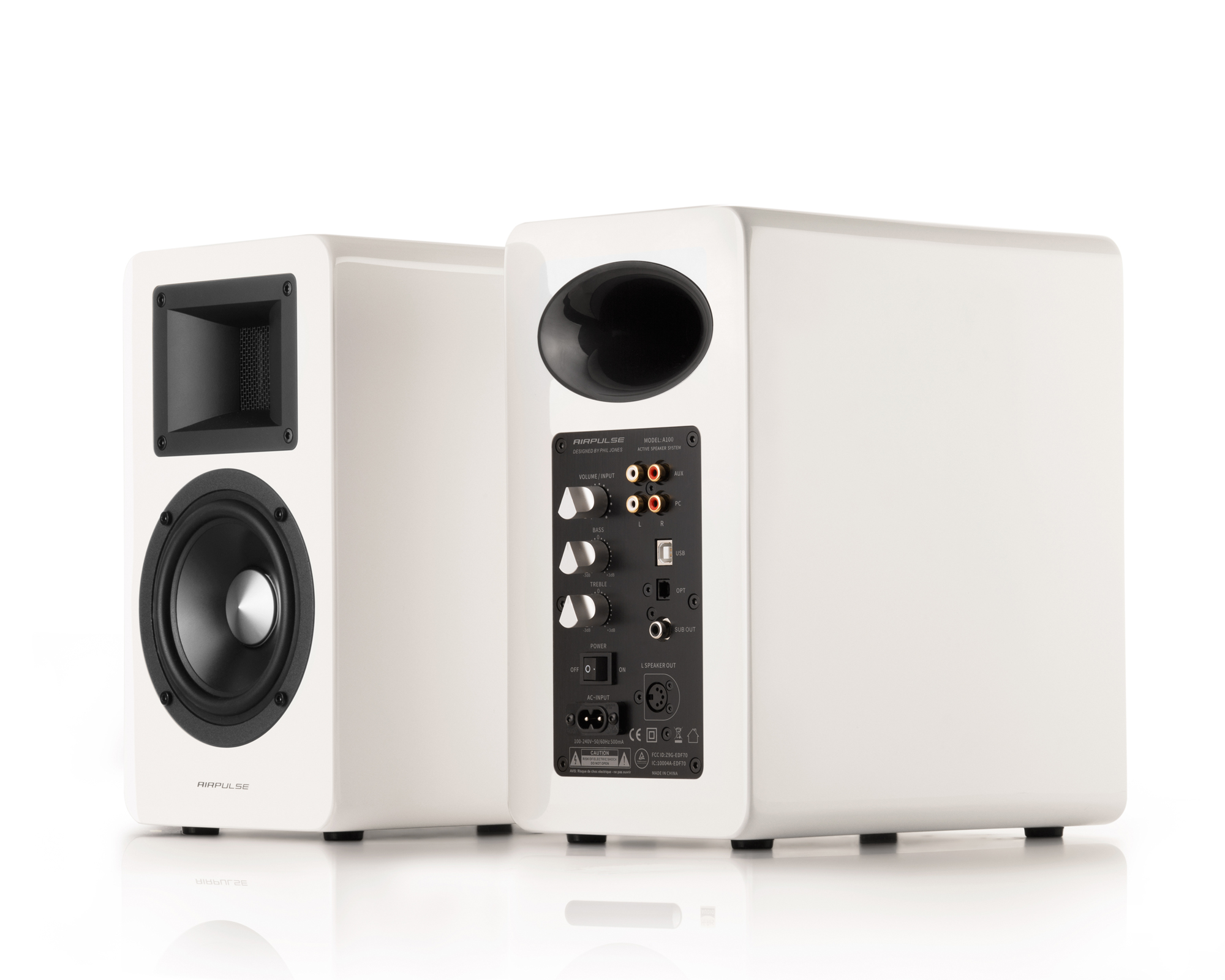

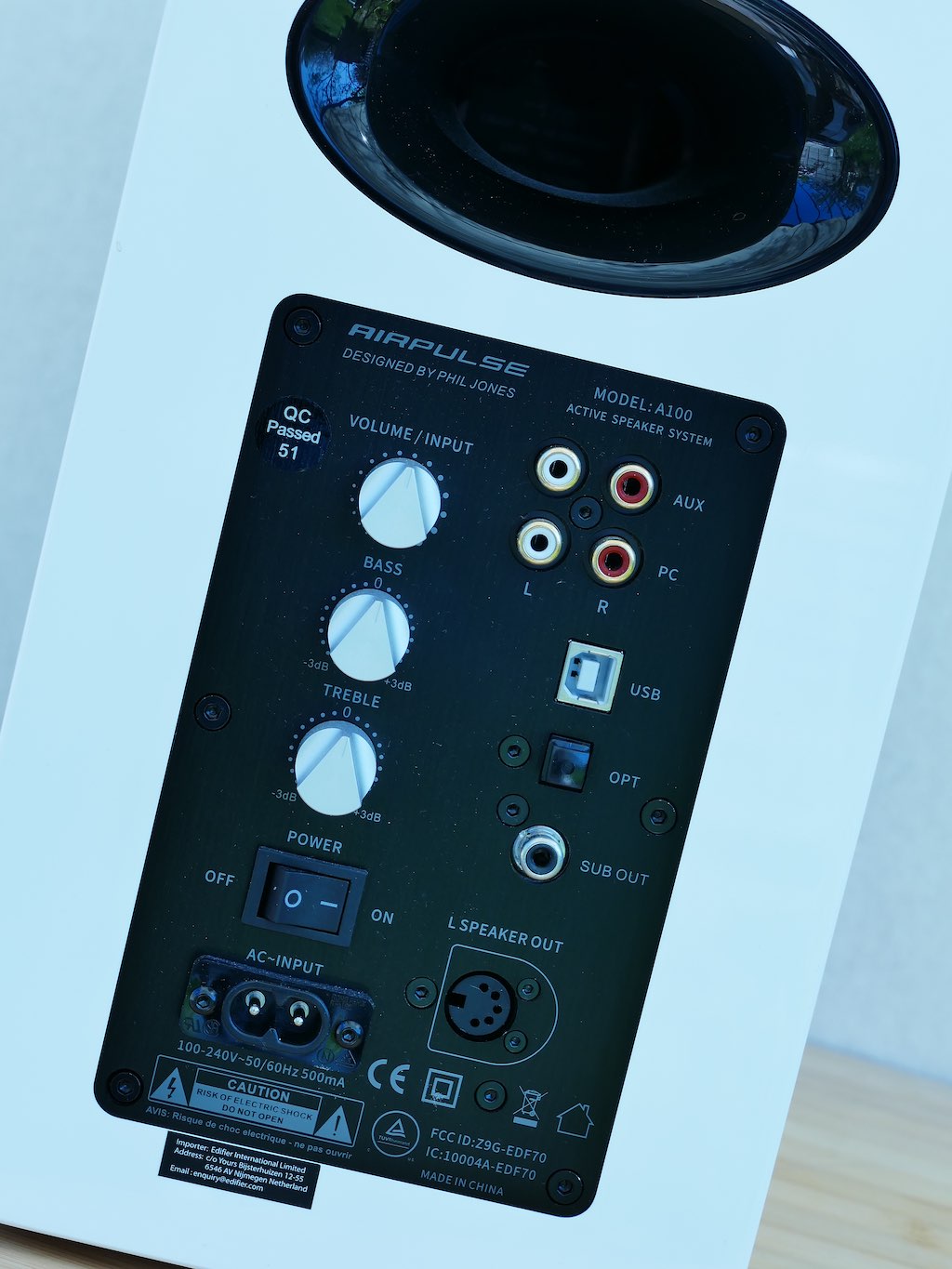

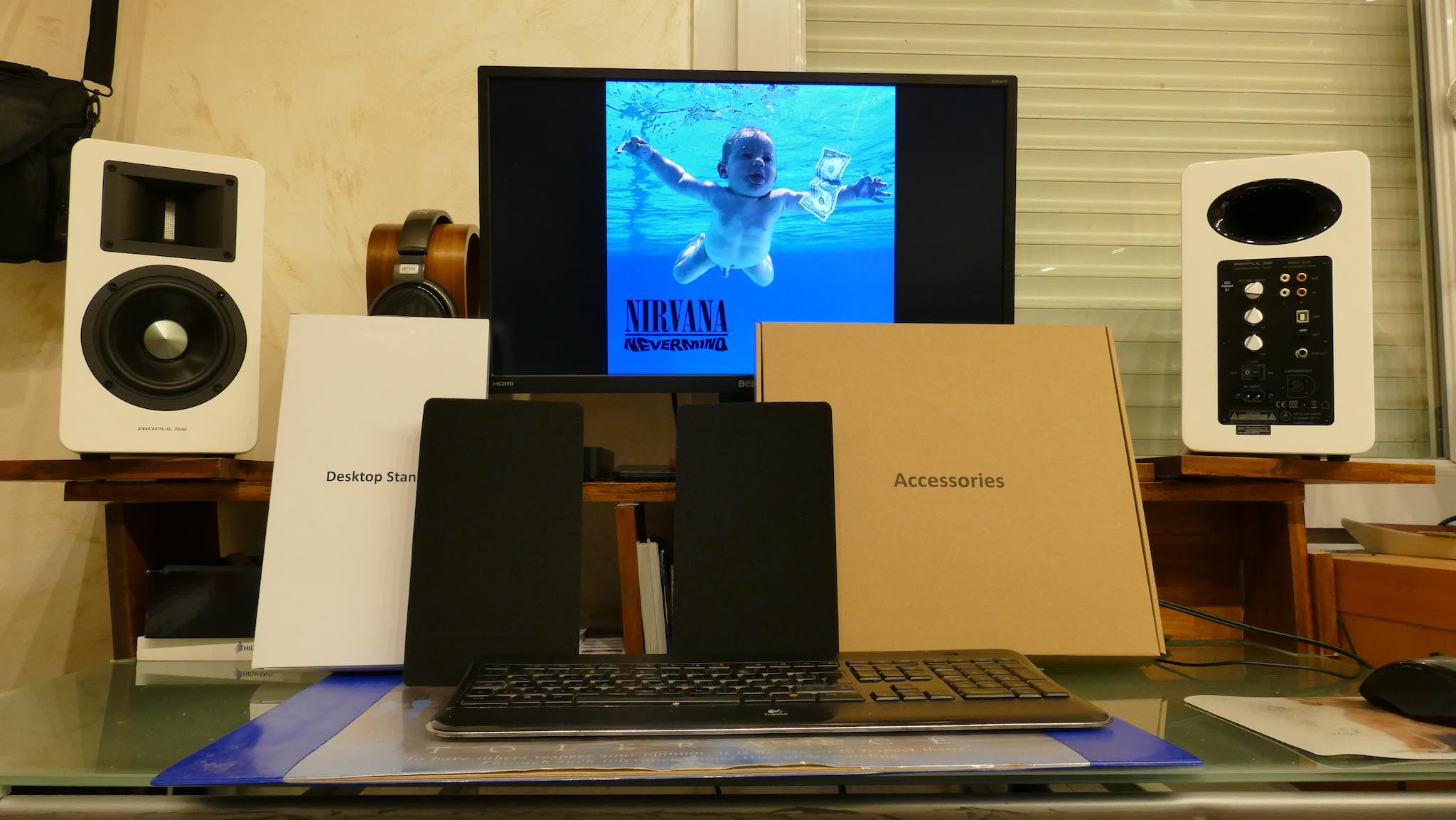

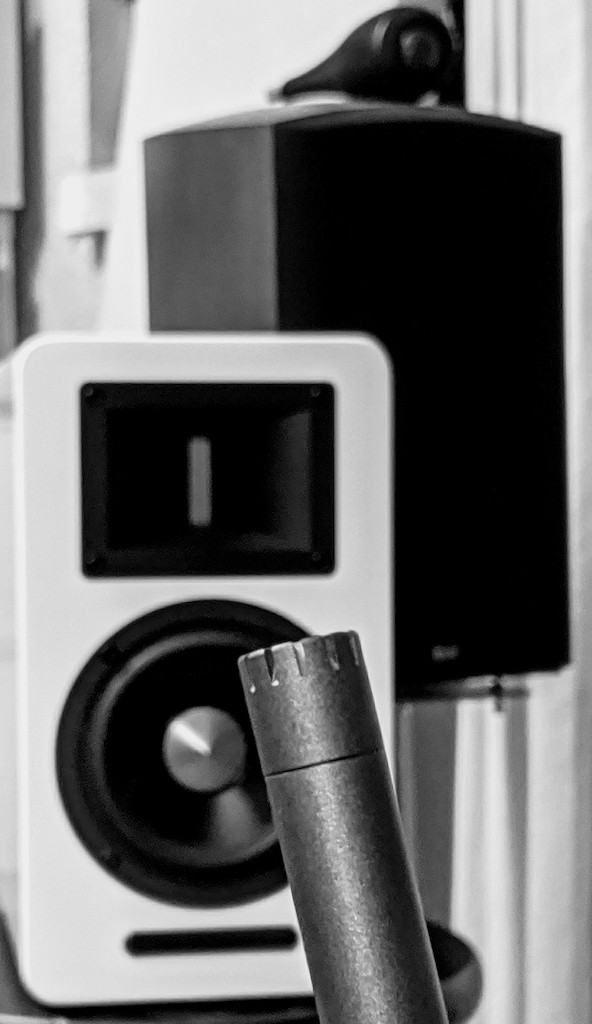


In the right corner: The AIRPULSE A100
 The AIRPULSE A-series is a signature product range designed by Phil Jones, an English musician and Pro-Studio equipment engineer, who, despite his name, isn't next of kin to the mass market speaker wizard Andrew Jones from ELAC, although Phil have had his apogee of success in Japan, likewise, when he was praised by JAS (Japan Audio Society) winning the Golden Sound Award as best loudspeaker developed in 100-year history of loudspeakers for the AIRPULSE 3.1, which were sold at whopping 275k $ per pair in 1997.
The AIRPULSE A-series is a signature product range designed by Phil Jones, an English musician and Pro-Studio equipment engineer, who, despite his name, isn't next of kin to the mass market speaker wizard Andrew Jones from ELAC, although Phil have had his apogee of success in Japan, likewise, when he was praised by JAS (Japan Audio Society) winning the Golden Sound Award as best loudspeaker developed in 100-year history of loudspeakers for the AIRPULSE 3.1, which were sold at whopping 275k $ per pair in 1997.
He designs as well speakers for the British Acoustic Energy brand, which he founded in 1987, while his USA based PJB (Phil Jones Bass) pro equipment venture has an excellent range of bass players from both American continents in the brand's rooster, just to name two marquee ones:
Gail Ann Dorsey (Davie Bowie) and Tony Levin (King Crimson & Peter Gabriel).
The AIRPULSE A-line of monitors , which is rather aimed at a consumer audience, is using the worldwide distribution network of Edifier International Limited, the Canadian-Chinese manufacturer, who owns the STAX brand as well. Today, AIRPULSE products are consequentially deriving from an exclusive heritage, the custom build studio monitors AIRPULSE AAD 7001i, which carry a monolithic price tag of 12.5 k USD.
Outer & Inner values: KANTO TUK
The TUK premium powered monitor gives the KANTO range of active speakers an astonishing new look.
KANTO confirmed on request that the company develops the product themselves. The manufacturing and shipping comes from renown suppliers in China, like Great Wall Technolgy Group (FCCid teardown) and Shenzhen Suyuan Industrial. The latter has some strikingly close but more colorful designs on offer, which are distributed under the brand Dragon Audio by Shenzhen Dragon Acoustic.
While KANTO did not only find an inspiring name for their product, they have as well an enchanting process story about the "making of" available in their blog for the TUK's design, which obviously must have been licensed to their manufacturer, who in turn used it to produce the Dragon Acoustic (not to mix up with Dragonfire Acoustics!) Supreme, A6, Tao 6 , Tao 7 and Dual 6 types of speakers. On a side note, according to Dragon's website visuals, the Tao 6 speaker was designed in Germany and in line with their instagram it has been part of their portfolio since 2017.
Air Motion Transformer tweeters like the 28x35 mm AMT in use, are known for excellent transparency and intriguing soundstage, while the 5.25 inch aluminum woofer visually resembles the low range transducer we know from the ELAC NAVIS series or likewise the bass driver from KEF's R-Series.
KANTO did not provide specific information about the amplification beside that the Class D technology deployed "doesn’t use DAC since the amp is full digital signal path" and apologized for not disclosing any information about DSP. While information about the analogue digital conversion (ADC) remained at low level, they revealed the implementation of the TI TPA613A2 headphone amp, joined by a Qualcomm CSR8675 BT module, a combination that is known to work well in the FiiO uBTR. It allows the TUK to receive data via Bluetooth 4.2 using AptX HD and AAC codecs. KANTO recommends likewise the use of 16-32 Ohm headphones with the HP output.
On the digital side of inputs, the C-Media CM6533 USB receiver provides a consumer class quality, which we can observe for example in the UGREEN USB Audio cards and affordable DAC/Headphone amps like the Syba Sonic 24bit, whereas the Cirrus Logic CS8416 192 kHz Digital Audio Interface Receiver for the optical input (Toslink) can be tracked down to some high end DIY DAC projects.
The TUK provides a subwoofer output, whose smart active filtering function, which is disabled by default, allows to send the frequencies below 80 Hz completely to your subwoofer of choice. The TUK then works in a reduced bass extension mode while the LFE signal will be cut off frequencies above 80hz.



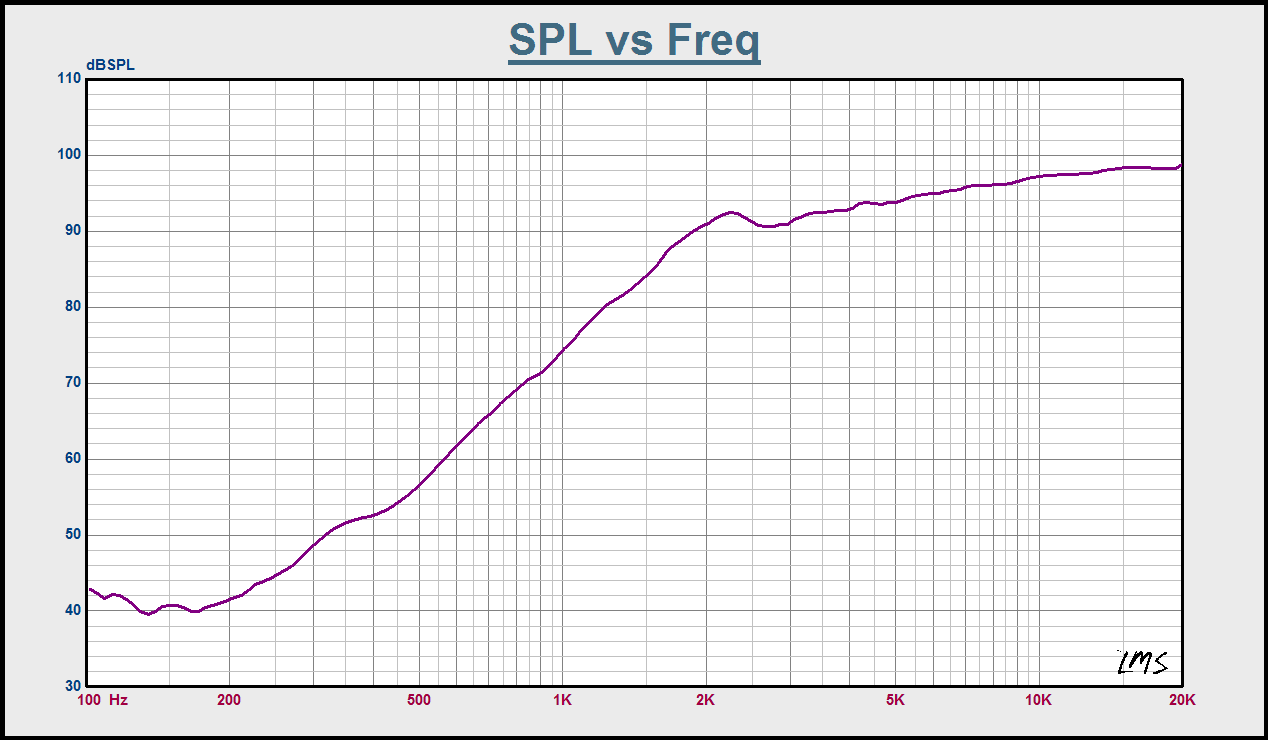


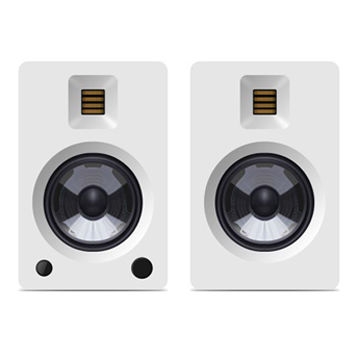


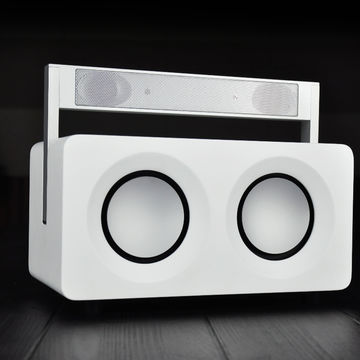
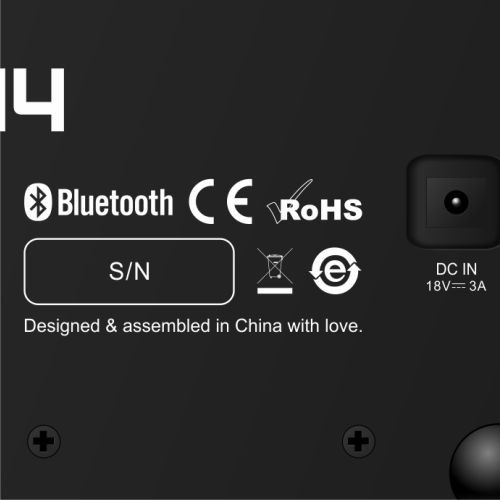


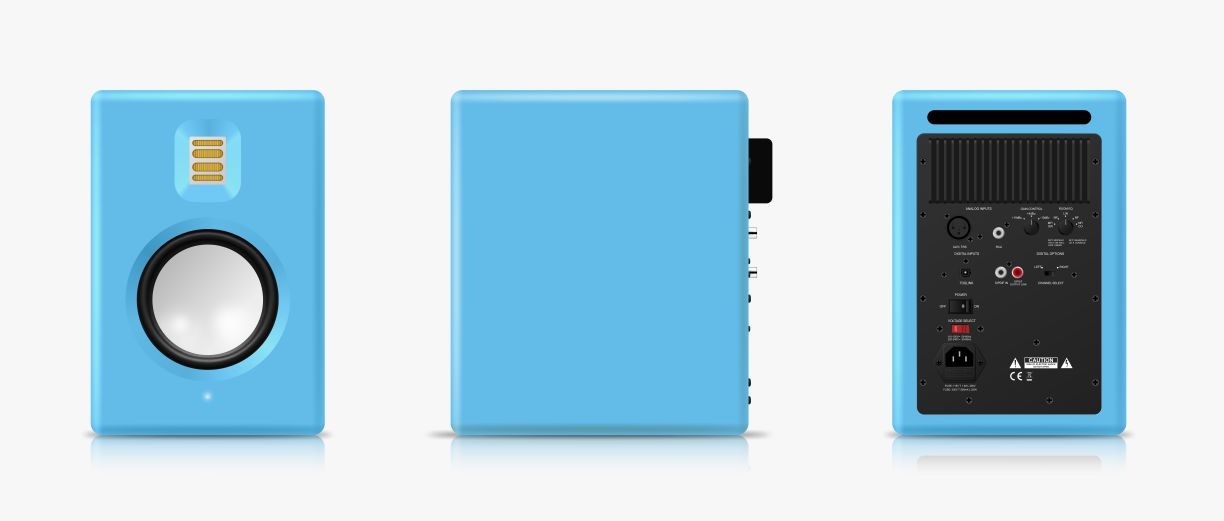


 If you decide to connect your record player to the TUK, the internal ADC switches the input sensitivity from 950mv to 10mv in order to support the signal arriving from MM cartridges.
If you decide to connect your record player to the TUK, the internal ADC switches the input sensitivity from 950mv to 10mv in order to support the signal arriving from MM cartridges.
Personally, I absolutely love the design of KANTO's remote control, which is clear and convincing, thus features some smart menu functions, which you only find out about if you read the KANTO manual carefully.
"The design of TUK’s remote started with an examination of the current YU-series remote. We noted the things we liked about it such as its size, shape, weight, and easy access to frequently used functions. We wanted to keep the same usability while adding additional functionality to TUK’s new feature-set. We did a hierarchical analysis to determine TUK’s primary, secondary, and tertiary features based on how often users would need to access them. The buttons were then laid out in response to this analysis, with the size and shape of buttons being considered as well. The result is a remote that feels right at home in anyone’s hand.” – Stuart MacMahon, Lead Industrial Designer of KANTO Living Inc.
Overall, the technology employed with these speakers, is perfectly destined to support an excellent lifestyle product, which ticks more boxes than any other active speaker I have seen at the price point. The TUK unites a striking presence with maximum inputs and a couple of clever comfort ideas. The sum of its features is simply extraordinary!
Outer & Inner values: AIRPULSE A100
Looking in the other corner, we discern that the A100 looks shiny and polished, sometimes in lovely cherry red, having a clean front finish without any appliance apart from the input display on the active speaker. They are set to impress with their sound quality, that's why they even do not sport a speaker grille and have no need to spoil their performance with nice-to-have comfort buttons on the front.
This teardown from 2018 may give you some ideas about the A100's overall build quality.
In my opinion, the A100's speaker resembles a lot more of the latest Acoustic Energy AE1 design than the AIRPULSE 7001 studio monitors, from which they’ve inherited the AMT technology like their siblings the A200 (2016), A300 (2017) and the upcoming A80 (2020), that comes with a smaller woofer as major difference to the A100
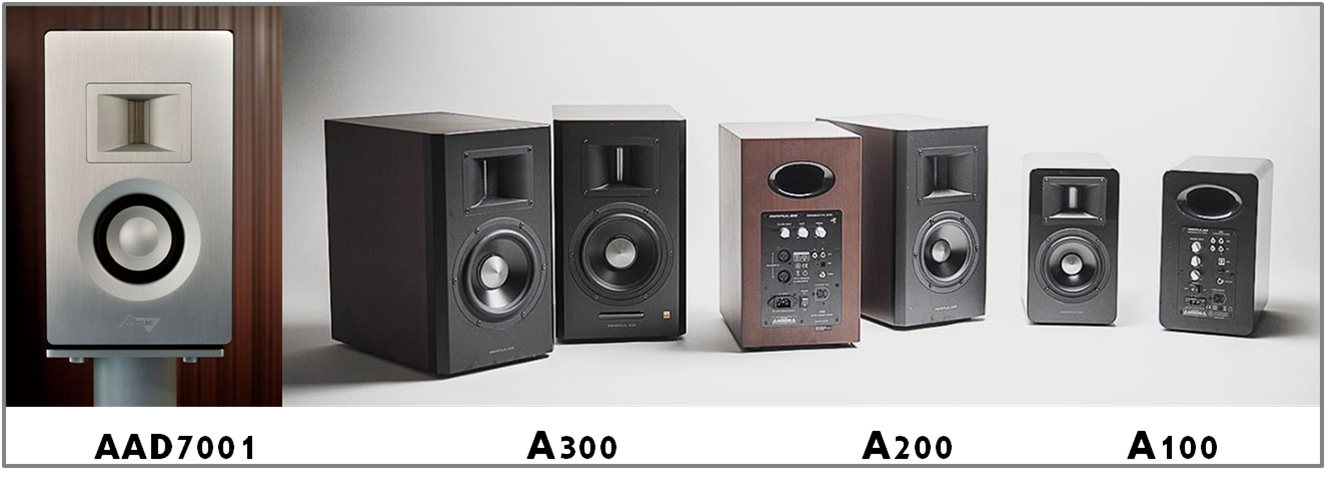
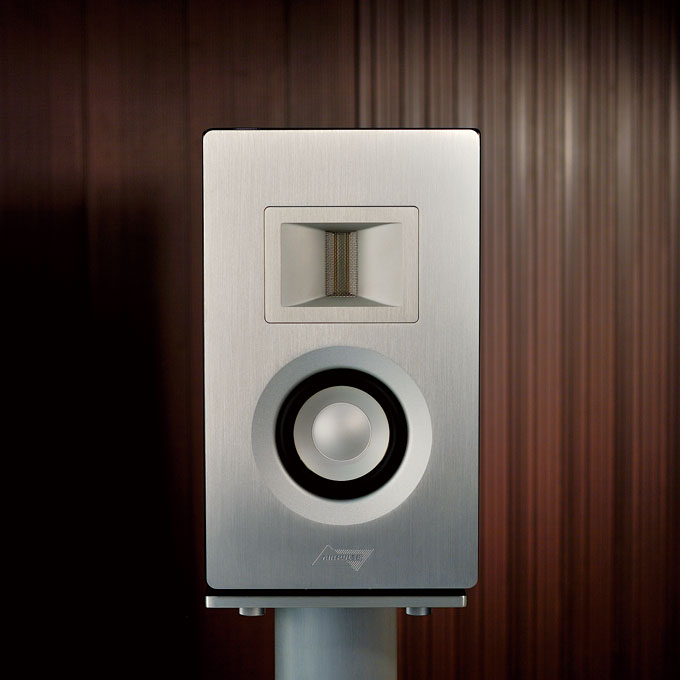








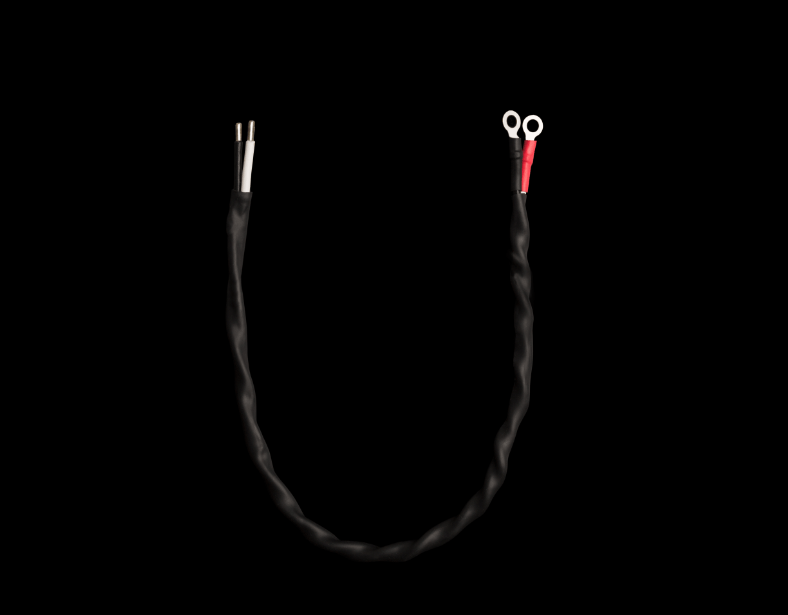

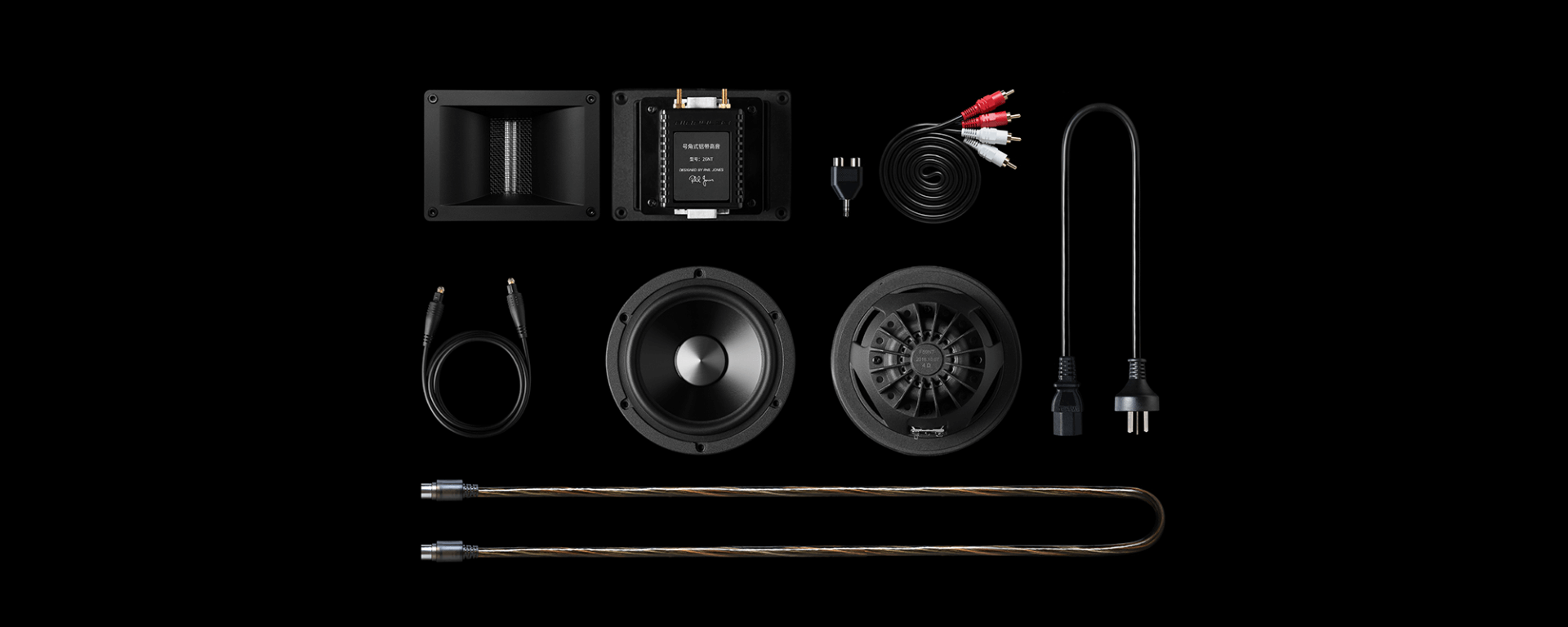
 Thus, we may assume the A100 is a crossover from the AIRPULSE 7001 and the Acoustic Energy's AE1 design. I need to note that Mr. Jones has already proven with the AE 1 that he is capable of designing incredibly small woofers with fantastic sound. In reality, the A-series speakers are products designed from a long experience of excellence, with a clear preference on performance over lifestyle.
Thus, we may assume the A100 is a crossover from the AIRPULSE 7001 and the Acoustic Energy's AE1 design. I need to note that Mr. Jones has already proven with the AE 1 that he is capable of designing incredibly small woofers with fantastic sound. In reality, the A-series speakers are products designed from a long experience of excellence, with a clear preference on performance over lifestyle.
The 65 mm Air Motion Transformer "tweeter came originally from our flagship 7001 speakers, and we made some changes in construction so we could make it affordable in the A-series speakers such as changing CNC machined metal parts for injection molding. Injection molding tools are extremely costly and only can be used for higher production quantities. So, we gambled on making super fidelity speakers beyond what was currently on the market, so audiophiles rich or not rich can easily buy them." explains Phil Jones in his insights, which you'll find as attachment to this review at the end.
The 5-inch woofer is based on a long stroke chassis design, something we have lately re-visited on Audiophile Style with Mitchco's PuRiFi 6.5 woofer review. While the A100 doesn't dive that deep down, the low distortion allows the driver to behave well controlled and increases its dynamic range.
 Whereas the crossover frequency of their siblings (A200: 2500hz, A300: 2000hz) has been published, the x-over point for the A100 wasn't disclosed on request. I'd assume it may be closer to the 3Khz mark. In my book the A100 sounded very balanced as long as you were not up to enormous volumes. It did not reach the level of control I've experienced with the ABACUS C-Box 3, but remained predominantly "faithful to the core". Some measurements - near field,, 80 cm distance at 70d, can be found in the first A100 slider.
Whereas the crossover frequency of their siblings (A200: 2500hz, A300: 2000hz) has been published, the x-over point for the A100 wasn't disclosed on request. I'd assume it may be closer to the 3Khz mark. In my book the A100 sounded very balanced as long as you were not up to enormous volumes. It did not reach the level of control I've experienced with the ABACUS C-Box 3, but remained predominantly "faithful to the core". Some measurements - near field,, 80 cm distance at 70d, can be found in the first A100 slider.
It’s paramount to note the A100’s very unique selling point:
These AIRPULSE monitors use internal wiring provided by TRANSPARENT CABLES! We all know how important good cables are in our audiophile cosmos. The Computer Audiophile uses TRANSPARENT CABLES and so does Bob Ludwig, whose mastering will be presented twice below, the sound wizard, who has his studio premises completely equipped by TRANSPARENT.
The electronic ingredients used by Airpulse are correspondingly carefully selected, although we shouldn't forget that we are still looking at a consumer class product here.
First of all, the A100 uses "only" 1 amplifier (TAS5754M Class D amplifiers from Texas Instrument) for each driver, contrary to the A200/300 which have one dedicated amplifier for each woofer and a third one for the tweeters, always in bridge mode.
Mr. Jones describes the design's advantage of improving the dynamic range over the whole audio spectrum by "using bi-amplification, as this greatly reduces the crest factor in a complex, wide-bandwidth audio signal and so improves the dynamic range". The TAS5754 does accept digital signals up to 192Khz, moreover, as a consequence from associating with the high frequency range of the AMT this qualifies the A100 for the Hi-Res audio certification from the JAS.
The 96Khz analog-digital-converter PCM1802 has been an established technology for AIRPULSE’s A-Series and Edifier active speakers. It can also be found in a wide range of affordable home cinema environments, like the Cary Audio Cinema 11a or Advance Acoustics X-Uni.
The optical input signal arrives via TI's digital frontend PCM9211, that's another commonly used standard for Edifier / AIRPULSE active speakers, however, it has also been implanted in accomplished audiophile products from Asus Essence over Luxman to Esoteric.
The USB input of the A100 benefits from the USB XMOS XU216 chip, whose excellent performance we know from some very recommendable audiophile products like iFi iDSD PRO and the Matrix Element X DAC.
Finally, the Bluetooth chip in use for the A100 is the Qualcomm CSR8645, which runs the Bluetooth 4.1 protocol. Noticing several announcements of BT 5.0 for the A100, I've decided to quiz the Airpulse product management for verification and got as a final answer : The new A80 design will sport Bluetooth 5.0, while the A100 - like the older siblings - features the CSR8645 BT implementation, thus with 4.1 firmware.
On the downside, the remote control has a quite minimal design, to put it mildly, it lacks the premium feel of the A300's control and the smart design from KANTO. Notably, the attenuation of volume leaves some room for improvement in the tactile domain.
As we know, careful implementation is king and often more than the sum of all parts, by virtue a domain where experience usually plays an important role. While the parts as a whole look like a reasonable choice for an "audiophile" consumer product, the expertise of AIRPULSE in implementing these components in their products may give them a real competitive edge against the KANTO TUK.
Limitations:
Purists may prefer exclusive amplification in each box, a solution which usually drives the price point and often limits to analogue / balanced inputs. As with most active speakers in the sub 1 k range, with the TUK and the A100 we'll find one active and one passive speaker, whereas AIRPULSE use separate Class d amplifiers for the different drivers. This concept allows them to use all the smart technology at one place, serving two masters.
Neither speaker set carries balanced inputs nor a Coax connection. As noted before, I personally didn't lack this comfort. Using the speakers as enhancement for the desktop experience, you may naturally select between two digital inputs or even BT, while the analogue input marks the route of last resort, although it may provide excellent sound quality.
What I found missing, firsthand, was the possibility to use the BT receiver in connection with a remote control app or supply BT headphones with music. I know that sounds quite picky, and yes it is obviously true, given the price point we are talking..
I've read continuously the assessment that both products are short of an integrated streaming solution, which in my personal opinion is rather an advantage than the opposite, because you can provide streaming functionality from any smart device using either an optical or the RCA input. As a matter of fact, it allows you to make personal choices and upgrades. For instance, if you want to listen to specific streaming services, just identify the suiting hardware for it and connect yourself digital or analog to these speakers. The smart part can easily be adjusted for small money using devices from big G or big A, via Toslink or RCA. For the more elevated friends of protocols and connectivity, a Blue OS device, a RPi or any equivalent SBC with USB audio output could be the way to go.
However, reflecting on my standard listening procedures, I too felt that I was missing some smart IP connectivity, may it be WiFi or Ethernet for the use of DLNA/UPnP/Airplay or even RAAT.
Evidently, I can be a very spoiled child, sometimes. The lack of MQA was not missed
THE LISTENING SPACE
Listening impressions from the AIRPULSE A100
Let's start with the A100, which I used primarily in two set ups: The mid-field arrangement on standmounts and the near-field experience on my desk. The latter would be my preferred use case during my daily routine and had as well ignited my desire to write this review.
THE MID-FIELD EXPERIENCE
For mid-field the A100 were fed via RCA in from either the PRE-out from the MOON Ace, using ROON in conjunction with the MIND 2 software from MOON or directly from the iFi micro iDSD BL. The DAC was sourced by Audirvana 3.5 from the CAPS Zuma with W10pro and Audiophile Optimizer. The alternative setup tested the optical signal via Toslink from my 2019 Philips 6704/12 TV, streaming from Prime video. All three setups were supported by the XTZ 10.17 EDGE subwoofer, x-over frequency 85 hz. 1. Mid-Field - MOON ACE - ESS9018 DAC - MIND 2 - ROON
1. Mid-Field - MOON ACE - ESS9018 DAC - MIND 2 - ROON
Narciso Yepes - Irish March - Arr. For Guitar By Narciso Yepes (Guitar Music - Grammophon (DG) - Qobuz - 16/44)
Yepes makes me feel that the Irish movement may be a bit drenched in melancholy, yet very powerful and dynamic and the direction is up and away for the upright Irishmen. The A100 did explain these nuances quite well, thought listening to that track you can identify their only problem, the amplification hasn't got enough substantial power and sufficient headroom for pushing over the notes with the necessary energy to blow Yepes' oeuvre the march in the mid field living room set up, whereas under near field conditions the small transducer plays this track with substantial verve and harmony
 2. Mid-Field - MOON ACE - ESS9018 DAC - MIND 2 - ROON
2. Mid-Field - MOON ACE - ESS9018 DAC - MIND 2 - ROON
Deep Purple - When A Blind Man Cries (Machine Head - Non Album B-Side - Remaster - Parlophone 2012 - Qobuz - 16/44)
This is one timeless piece of beauty I had discovered on my first Deep Purple double record (Mark I &II) around 1977, when listening to their Mark II incarnation, which I preferred as a testosterone driven teeny. While recorded during the "Machine Head" sessions at Montreux in December 1971, the piece was only published as b-side for the single "Never Before".
This song carries a prime memory for me, the one of my Grandma's mum, who I may have known only for a year or so, almost ever sitting at the same chair in the same room, almost blind and with reduced mobility, smelling strange & old to me. She disappeared from my world before I celebrated the fourth birthday. A specific memory, which came back with this song some 10 years later.
For a long time I have wondered why I have never found this song on any regular Deep Purple record, however, the answer lies in Ritchie Blackmore's distaste for the song (which in turn is an Ian Gillan favorite), who voted against the use of it on Machine Head and never played it live while he was with the band.
The tender voice of Gillan combined with the Blues inspired guitar soli did not correspond too well with the overall power driven ambition of Blackmore on Machine Head. This album is a Rock classic by every standard, a destiny that the abandoned tune has experienced only after Blackmore departure from Deep Purple.
Quite interestingly, the A100 presented Jon Lords keyboards more prominently than I've (faintly) remembered. I’ve listened to the track over the pre out of the MOON ACE, taking advantage from Roon's compatibility & control over the ACE's MIND 2 software, a combination which showed great transparency and the tender build up of the AIRPULSE's soundstage. However, the balance function of the MOON did shock me as a small move to the right or the left had an unexpected great impact and simply killed the soundstage (distance to speakers 2,50 m). In the near field I did not experience any sweet spot problem.
 3. Mid-Field - MOON ACE - ESS9018 DAC - MIND 2 - ROON
3. Mid-Field - MOON ACE - ESS9018 DAC - MIND 2 - ROON
TOOL - Invincible (Fear Inoculum - RCA Records 2019 - Qobuz - 24/96 )
This is from my personal Album of the Year 2019, "Fear Inoculum" from Tool. The tale about our loss of importance, our degeneration, our decay, our misconception of finding "Ponce de Leon's phantom", the fountain of youth, yet again.
The song, an exceptional piece of work, shows, after all, the special talent of Danny Carey and the "masterwork" skills of Bob Ludwig. I feel the album is an outstanding product for audiophiles. because it touches my senses and makes my system sound far better than it is. With the A100 in mid-field I noticed again the need to push the volumes in order to receive sufficient output for the sub support. During the sequence of painful reflection starting at 7:02 the AIRPULSE shows painstakingly how faithful to the source they perform.
 4. Mid-Field - iFi micro iDSD BL - CAPS - AUDIRVANA 3.5
4. Mid-Field - iFi micro iDSD BL - CAPS - AUDIRVANA 3.5
Shudder to Think - X-French Tee Shirt (Pony Express Record - EPIC 1994 - Qobuz - 16/44)
Another mastering by Bob Ludwig, produced by Andy Wallace, who's better known works comprise his collaboration with Nirvana and Rage against the Machine. Shudder to Think were one of the bands on Ian MacKaye's Dischord Label that were different, more Pop, more aesthetics, more distinctive from the rest. They took the step up to major distribution, signing for EPIC, when mastermind Jack Wedren's chronic illness took over and left them in the obscure company of bands that never achieved (lived up) up to their capabilities. X-French Tee Shirt had a strong MTV rotation in 1994, that’s why I have searched for the video on youtube as a goodie.
"While the band's cocktail of tricky time changes, aggressive guitar bursts, and Craig Wedren's effeminate falsetto proved inaccessible for the mainstream, many musicians found it utterly compelling", even Pearl Jam covered them. Wedren's unusual high pitched voice is a real test for your tweeter's quality, a task which the A100 excelled with passion, control and harmonic balance.
 5. Mid-Field - iFi micro iDSD BL - CAPS - AUDIRVANA 3.5
5. Mid-Field - iFi micro iDSD BL - CAPS - AUDIRVANA 3.5
Carmen Gomes - Summertime (The visual sound - sound liaison 2019 - Audirvana - DSD256)
Gershwin's wonderful emotional and tender ballad in a masterful version from Carmen Gomes and her musicians, a bit dystopian in the timbre but truly audiophile. It surprised me a lot when the entry bass notes came out of the speakers without any distortion or hiccup, though the A100 were able to keep the bass level clear and present throughout the song, when the volume was pushed a bit higher than usual. The voice of Carmen is given some unearthly presence and shape while the musicians and their instruments took advantage of the aural space created by the AMT in the upper midrange.
 6. Mid-Field - Toslink from TV Philips 6704/12 - Prime Video
6. Mid-Field - Toslink from TV Philips 6704/12 - Prime Video
Neil Young - Far from home (Heart of Gold by Jonathan Demme, 2006, Prime Video, 1080p, HD+)
The only source with Toslink feed in the office/man cave is my 2019 Philips TV. I expected not much when I scanned Amazon Prime for some concert videos. I actually searched for a specific Jerry Garcia documentation, which I couldn't find, finally I went with "Rammstein live in Paris" and Neil Young's Concert in the Ryman Auditorium, Nashville, called "Heart of Gold".
I've been a real fan of Neil Young's live performances since I'd heard "Rust Never Sleeps" in '78, however, the newer performances - for my gusto - were often too explicit country and a bit pastoral sometimes. Subsequently, I was surprised how excellent I found Neil Young's concert in the Ryman Auditorium, which was pictured by Jonathan Demme on the 18/18th August 2005 in Nashville, Tennessee and available 2020 on Prime Video in France.
For its broad presentation of a three voiced chorus in the back, Lap steel guitar on the left, an excellent brass section on the right, harmonica and acoustic guitar with Neil's voice in the centre, I took "Far from home" in the search for the limits of the AIRPULSE. I was clearly mistaken.
Placement, stage, transients, even PRAT, the monitors were as faithful to the source as you can ask for in this category. As a consequence I found myself loving this song I’d heard the first time with that stream, due to the great performing musicians on stage and the convincing quality of the A100's as shining partners of Philips' ambilight TV.
 7. Mid-Field - Toslink from TV Philips 6704/12 - Prime Video
7. Mid-Field - Toslink from TV Philips 6704/12 - Prime Video
Rammstein - Mein Teil (Rammstein:Paris, 2017, Prime Video, 1080p, HD+)
Being German by nature, I despise Rammstein. For their vulgarity, their cultural tribute to the uprising of the new German alt right, their unmistakably misogynistic role play. In contrast, my French brother-in-law just adores them, because he can overlook these facts and just enjoy the show.. He has been at one of the events that were recorded for their live show release "Rammstein:Paris", which I found in the Prime Video program, when I looked for content to test the A100. I choose one from the many disgusting performances, "Mein Teil", due to its overwhelming low atmosphere built on simple sequences of extremely deep frequencies. Using the PCM9211 based Toslink input, the AIRPULSE were performing astonishingly great, taking a proper advantage of the subwoofer output. I wish I could fade out the song's background and lyrics and concentrate on the music only to enjoy the overwhelming soundscape. I can't, and therefore I suffered, it is such an appalling piece of provocation. Nevertheless, it showed how good the low end trajectories of the A100, which are rated down to 52 hz only, were in collaboration with the 10" XTZ sub.
The A100 did not have the low tone foundation and the overall bass control I had experienced with the class A/B driven ABACUS C-Box 3 last summer, though their tonal balance and transparency, the extended soundstage, their detailed midrange and their smooth top range give them an overall advantage against them. En plus, their choice of inputs provide the A100 some serious edge in comparison. Their only imperfection: you can't go stupidly loud with these monitors. In my personal perception playing VERY LOUD wasn’t the highest of virtues for these small Hi-Res heroes, while playing up to 85 db straight in your face in the near field shows highest accuracy and can lead to veritable audiophile pleasures.
THE NEAR-FIELD MAGIC
In my workspace the A100 were connected via USB to either the computer or a mobile phone (OTG). The second configuration comprised either my headphone amp's line output, fed by the Khadas Tone Board with a ESS9038q2m DAC chip via analogue output or the KDTB en direct to the RCA inputs of the AIRPULSE.
 8. Near-Field - Khadas - Roon
8. Near-Field - Khadas - Roon
Bob Dylan - Murder Most Foul (Columbia 2020, Qobuz DL - FLAC 24/96)
I figured out that I need at least to listen another 30 times to the lyrics for getting a full picture from all these cultural references Dylan uses. Especially, because I experienced my permanent eclipse from Dylan full and sonore voice into the underlying soundscapes, usually starting after 4 minutes. In my book, the dynamics, the extreme low end and the aural space given to the sparse instrumentation makes it a recommendable audiophile recording.
Before I bought the track as a 24/96 download from Qobuz, I listened to the YT performance on my TV. Obviously limited by the low quality codec, the music transported by A100+Sub resonated with me in a click, while the Hi Res version in the near field just left me stunned. The song has some desk shattering, very deep infrasonic bass, reminding me of the sine wave with deep volume modulation used by James Blake.
 9. Near-Field - Khadas - Roon
9. Near-Field - Khadas - Roon
Youn Sun Nah - Hurt (Lento , ACT - 2013 - Qobuz, 24/96)
This song, carrying a special presence in the midst and upper ends, comes with no sudden need for a subwoofer. Which suits the AIRPULSE very well, because they can provide just brilliantly Youn's emotional voice and the tender guitar picking. A feast for any Air Motion Transformer. The song, known from the great late Johnny Cash, was originally recorded by NINEInchNAILS on "The Downward Spiral" in 1994.
 10. Near-Field - USB - Roon
10. Near-Field - USB - Roon
Avishai Cohen & Big Vicious- Teardrop (Big Vicios - ECM 2020 - Qobuz - 88,2/24)
The trumpetist, a descendent from a very musical family in Tel Aviv, Israel, who returned home recently after years in New York, celebrates his art with an electro-acoustic sextett setting on this exciting new ECM album Big Vicious. The Massive Attack cover "Teardrop" is simply celestial, airy, consequent, maybe just perfect. A piece to be proud of.
The production gives the instruments room to breathe and the notes space to wander.
Songs like this and the track before are just perfect show pieces for speakers with the characteristics of the A100.
 11. Near-Field - USB - Roon
11. Near-Field - USB - Roon
Jacques Brel - Le Moribond (Infinitement - DRG Records 2004 - Qobuz - 16/44)
I audited a dozen of versions from Jacques Brel's "Le moribond" before I went for the version present at the double CD "Infinitement" (also available as SACD) in CD-quality stream from qobuz. I'd reckon, In North America this song is better known as "Seasons in the Sun" sung by Terry Jacks.
Brel's original recording encapsulates the special spirit of departure and his "I know it all" attitude revealed towards his loved ones. The A100 presents the classic interchange of solo instruments precisely, always with respect behind Monsieur Brel, once right, once left, always with a good depth of stage.
 12. Near-Field - USB - Roon
12. Near-Field - USB - Roon
Cutler Elisabeth Cutler - Sanctuary (Silence is Rising - Tasal 2019 - Qobuz - 24/44)
Madame Cutler's 7th album was one of the slow burners in 2019, I had this song on rotation like forever, it feels.
The independent artist, who resides in Italy, has a distinctive style of guitar play, and "Sanctuary" shows nuances of the mid tempo brilliance we know from Loreena McKennitt, minus the mystics plus cheeky self reflections. The arrangement is musically broad, and I enjoy the moment hearing her lively voice, accompanied by chrotta, dholla and udu drums, rehashing "when I was a horse ...". Just lovely and the rich acoustic folk-world style opens up my mood anytime I get it in the near field.
 13. Near-Field - Bluetooth - POCO F1/Qobuz App
13. Near-Field - Bluetooth - POCO F1/Qobuz App
Dan Auerbach - Street Walkin' (Keep it Hid - V2 2009 - Qobuz - 16/44)
This song sounds like Mr. Auerbach (which is by the way the name of a castle erected by King Charlemagne close to Heidelberg) have had a fair share of jams with George Thorogood. The sound quality is mediocre at best, but I love to hear it over Bluetooth in my car.
With the A100 it did not work that well. Too faithful. Loved the Glockenspiel at the outro, though.
 14. Near-Field - Bluetooth - Apple XR / Napster
14. Near-Field - Bluetooth - Apple XR / Napster
Yiruma - River Flows in You by Jeroen Van Voen
For the final test, I've invited my 16 year old son to rehearse some music from his phone at my desk.
As a piano scholar in younger years, he loved to show his Piano skills during the last year on public pianos at SNFC stations in Bordeaux, Troyes, Gare du Nord and especially close to his schoolyard in Tours. I asked him to play his preferred piano piece to me. Even as 128k MP3 streaming on Bluetooth he told me without hesitation that Jeroem Van Voens presentation sounded a lot closer to the natural sound like the ones he experiences while playing himself.
I then changed the signal path to analogue inputs, Khadas DAC, Qobuz 24/96 stream and planted a distinctive seed for a lifelong career as audiophile.
The AIRPULSE A100, especially in the near-field experience, are simply the perfect gift for audiophile beginners due to the AMT's precise but silky yet detailed and transparent presentation.
In the midfield area they definitely take advantage of subwoofer support, though they demand to be pushed for elevated volume to cover sonic spaces comprehensively.
PUBLIC QOBUZ PLAYLIST : https://play.qobuz.com/playlist/3101169
Carmen Gomes - Summertime: https://www.soundliaison.com/index.php/536-sound-liaison-dxd-music-sampler
Listening impressions from the KANTO TUK
While KANTO told me a t least 5 times in the last 6 month that the review units were on their way to my address, they unfortunately have never arrived here. To get some more flesh about their acoustic performance into my review, I asked my gentle colleague Sonis, who happens to own a pair of them, to answer some basic questions about these speakers. Kudos to Sonis for his straight response.
Note: In Part 2, Ducktoller reviews the Kanto TUK - https://audiophilestyle.com/ca/reviews/review-kanto-tuk-vs-airpulse-a100-part-2-r939/
1) Which is your general use case for the TUKs? Do you use them in a 2.0 or 2.1 system?
Sonis: They make decent desktop near-field monitors. The remote control makes them very convenient to use. 2.0.
2) Do you think that their Phono input or Headphone output live up to audiophile standards?
Sonis: No! If I was TUK, I would drop these features. I understand why they are there. Small apartments, dorm rooms etc. would find an all-in-one system with features like that useful. But they are all mediocre at best. A simplified pair of these without the bells and whistles would be a good buy.
3) Do you feel that they provide sufficient bass?
Sonis: Average for their size. Roughly 60Hz bass is normal for a speaker of this size.
4) Do they have an exciting midrange? Is their AMT speaker sometimes fatiguing?
Sonis:The AMT is a remarkable transducer wherever it’s deployed. It makes the upper midrange shine. Not (fatiguing) in my experience.
5) Would you call their sound balanced and uncolored?
Sonis: Balanced, yes. Uncolored, no. I own a similar pair of speakers (not powered, though) the Martin Logan Motion 4xi with an AMT tweeter, and they are much more transparent.
6) Would you call them audiophile desktop speakers?
Sonis: I’d call them desktop speakers. I suspect that their class-D amp is the limiting factor.
My personal KANTO experience:
KANTO failed me, repeatedly & miserably.
They contacted me at the end of August and promised to me to make review units available starting September 2019. For the end of September ... November ... January ... , then in February I was told they were already dispatched to my address ... finally, my press contact hilariously missed the date and promised them for April already on the 31st of March. As a consequence, despite 8 month of communication with KANTO, they just never made it to my desk.
To add more pain to my misery, my requests for detailed information, i.e. about crossover frequency, DSP and which Class D technology is used etc., were always answered magically without any bit of useful information. For sure, I am kind of embarrassed about that, however, as the KANTO TUK is obviously available in the trade, I wanted to give the product the fair share of recognition it deserves, unrelated to the manufacturers failings to deliver anything they promised over the last 8 month.
Subsequently, in the last lane starting April, my research led me further than I actually had desired to know. I decided to publish this info because it helps you reader significantly to understand what kind of product you aim to buy and how it compares to a close competitor. I decided that I did not want to waste all of the efforts, and have still continued with the comparison until the end, pointing out as much strength of the products I could find in my research. In my opinion the review bears balanced and valuable information for you, our readers.
Final words:
Not as much “en vogue” and stylish as the KANTO TUK, the AIRPULSE A100 are trickled down from audiophile studio technology that has been around for a while and their characteristic is much closer to studio monitors than to lifestyle-Fi. The AIRPULSE A100 shows enormous quality and value as a digital connected active nearfield desktop speaker.
In a living room environment I'd see them as an affordable yet excellent choice for audiophile beginners, especially when used with a subwoofer in a 2+1 combination. If you're in for bigger spaces, I'd advise to check out their grown up sibling A-300.
The mix of carefully selected premium materials, drivers, experience & craftsmanship combined to an impressive effort of Phil Jones's design, culminating into transparent and detailed sound presentation, makes the AIRPULSE A100 an outstanding value at a minimum footprint, proposing us affordable yet audiophile comfort & pleasures in our workspace.
In short, the A100 doesn't care about lifestyle gadgets, they are all about careful sound reproduction, performing best in a nearfield environment, and they do that excitingly well for the money.
The TUK, at the other corner, is definitely a near perfect lifestyle product, while it lacks the audiophile pedigree, quality components and performance of the A100. For convenience you may want to consider the TUK, for transparent near field sound production in your workspace go with the AIRPULSE A100!!
SPECIAL ANNOUNCEMENT:
In relation to these difficult C19 times and as a consequence of the economic crisis worldwide, AIRPULSE proposes some products (including the A100) at special discount on limited offer until the end of MAY 2020:
The AIRPULSE A100 will go ahead with a 40% code (see conditions below) to be used in continental Europe & UK when buying one pair of their A-Series from their website AIRPULSEPRO.com.
For less than 540 EURO, a pair of A100s sounds like the REAL thing, in my personal opinion.
For all US based readers, Airpulse/Edifier provides a special discount for the A100 speakers. They can either use this link and the code will be automatically applied or enter the coupon code “audiophilestyle” at https://edifier-usa.myshopify.com to enjoy the price of 640 USD , which is 20% off from 799 $.
Terms of the discount : The discount code for customers is 40FORU All orders must be placed via the website www.AIRPULSEpro.com
- valid for all residing within the UK and Europe only.
- Discount period is from May 6th till May 31th, 2020.
- All purchased items will enjoy AIRPULSE 2 year warranty
-
Original price in Euros
- A100 – 898€ / discount 40% = 538.80€
- A200 - 998€ / discount 40% = 598.80€
- A300 – 1,280€ / discount 40% = 768.00€
-
Original price in Sterling Pounds :
- A100 - £788 / discount 40% = £472.80
- A200 - £878 / discount 40% = £526.80
- A300 - £1,199 / discount 40% = £719.40
Product Detail Archives:
- Kanto TUK (9 MB PDF)
- Airpulse A100 (20 MB PDF)
Associated hardware in play:
★ Amplifier/Pre - MOON ACE with ESS9018 DAC, Mind 2
★ iFi iDSD Black DAC & Headphone Amp
★ CAPS ZUMA w/PPang USB V2 card, WIN10/WS2016-AO-JRIVER-ROON & AUDIRVANA 3.5
★ HDPLEX 100w linear power supply
★ Khadas Tone Board DAC
★ Oehlbach Cinch cable NF1 Master
★ UNRAID 6.7 NAS 12 TB
★ Xiaomi Pocophone F1
★ Apple IPhone XR
Software:
★ Qobuz
★ Roon
★ Audirvana 3.5 for Windows 10
★ Audirvana for IOS and Android
★ Audiophile Optimizer 2.35















Recommended Comments
Create an account or sign in to comment
You need to be a member in order to leave a comment
Create an account
Sign up for a new account in our community. It's easy!
Register a new accountSign in
Already have an account? Sign in here.
Sign In Now